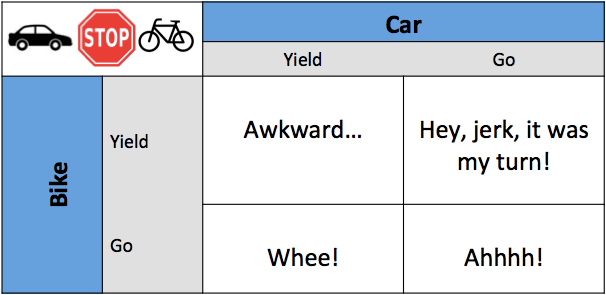Cyclists have a reputation for ignoring traffic rules — running red lights, ignoring stop signs, and generally riding in a risky way. While it is a stereotype, it contains some truth that reflects the habits of even safe bikers. We would like to suggest a simple explanation for bikers’ behavior: avoiding awkwardness.
Some context: the conflict between bicyclists and drivers is a fierce one, comparable to the divide between climate skeptics and environmentalists or elves and orcs.
Bikers often see themselves as second class citizens, enduring obstacles in the bike lanes and cars that feel free to cut them off. “In general, as a cyclist,” writes one San Francisco biker, “you are either invisible, and therefore vulnerable, or you are seen and hated.”
To drivers, every biker behaves like Fred Armisen’s character on Portlandia (see below) who constantly yells “bicycle rights” as he belligerently barrels through traffic and charges past pedestrians on the sidewalk.
Even a Times op-ed written from a biker’s perspective, however, acknowledges the problem of “cyclists running stop signs like immortal, entitled fools.” So do drivers have the moral high ground? Are bikers really a bunch of jerks?
As avid cyclists, we certainly don’t think so. Only a small minority of cyclists run through intersections. As a community organization in San Francisco maintains while defending cyclists, “Everybody wants to eliminate the about five percent of cyclists who violate other people’s right-of-way.”
And while the common practice of cyclists rolling through intersections with stop signs contributes to this image, we’d argue that this is not by itself an issue. Idaho law allows bikers to treat stop signs as yield signs — a sensical reform that allows bikers to save momentum by slowing rather than stopping when no traffic is present. (Many stop signs exist to keep cars from speeding rather than to control the flow of traffic.) It also maintains focus on the real problem of bikers who ignore right-of-way rules by blasting past cars that arrived at an intersection first.
But the reason so many cyclists — and not just the Steve Jobs of biking — ignore right-of-way rules and roll right through intersections is that it seems to be expected. In other words, drivers are complicit. Bikers who come to a full, law abiding stop at 4-way intersections often experience long, awkward encounters with drivers who have the right of way yet insist the biker go first. From a biker’s perspective, these are often the potential outcomes when approaching an intersection around the same time as a car or cars:

In a sense, given that so many drivers always wait on bikers, going first, even if you don’t have the right of way, is the best choice for bikers. This isn’t always the case, but awkward “you go, no you go” experiences at intersections can be so common that bikers try to slow their arrival at intersections so that cars know to go first. When that fails, it can seem more efficient to slow down but otherwise assert that you are going through first. (Although not at all the best choice from a safety perspective.)
It’s unclear why cars so often defer to bikes even when the driver has the right of way. The fact that bikers seem like pedestrians may lead some drivers to assume they should defer to bikers like they do to senior citizens with walkers. Alternatively, bikers could feel more free to ignore right-of-way and charge out because they are much less likely to cause serious damage than a driver. (Although bikers are also more vulnerable.) Or it could be the fact that bikers like to pull California rolls rather than full stops to preserve momentum, which makes drivers fear that the bikes won’t yield at all.
However it started, the fact that a substantial enough number of bikers don’t follow the right-of-way rules has now made it a self-fulfilling prophecy. Cars don’t expect bikers to follow the rules, so otherwise law-abiding bikers fulfill that expectation.
This post was written by Alex Mayyasi. Follow him on Twitter here or Google Plus. To get occasional notifications when we write blog posts, sign up for our email list.




